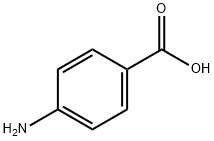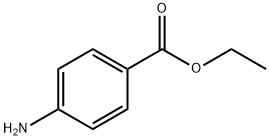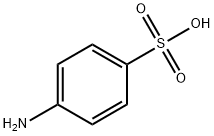4-Aminobenzoicacid , 10mMinDMSO , 150-13-0
Synonym(s):
4-Aminobenzoic acid;PABA;para-Aminobenzoic acid;Vitamin Bx;Vitamin H1
CAS NO.:150-13-0
Empirical Formula: C7H7NO2
Molecular Weight: 137.14
MDL number: MFCD00007894
EINECS: 205-753-0
| Pack Size | Price | Stock | Quantity |
| 1ml | RMB159.20 | In Stock |
|
| others | Enquire |
PRODUCT Properties
| Melting point: | 187-189 °C(lit.) |
| Boiling point: | 251.96°C (rough estimate) |
| Density | 1.374 g/mL at 25 °C(lit.) |
| bulk density | 200kg/m3 |
| vapor pressure | 0Pa at 25℃ |
| refractive index | 1.5323 (estimate) |
| Flash point: | 250 °C |
| storage temp. | 2-8°C |
| solubility | 95% ethanol: soluble5%, clear to slightly hazy, colorless to yellow |
| form | Crystalline Powder |
| pka | 2.50, 4.87(at 25℃) |
| color | White to light yellow |
| Odor | Odorless |
| PH Range | 3.5 |
| PH | 3.5 (5g/l, H2O, 20℃) |
| biological source | synthetic (organic) |
| Water Solubility | 4.7 g/L (20 ºC) |
| Sensitive | Air & Light Sensitive |
| Merck | 14,423 |
| BRN | 471605 |
| Stability: | Stable. Incompatible with strong oxidizing agents. Combustible. Sensitive to light and air. May discolour on exposure to light. |
| InChIKey | ALYNCZNDIQEVRV-UHFFFAOYSA-N |
| LogP | 0.96 at 25℃ |
| CAS DataBase Reference | 150-13-0(CAS DataBase Reference) |
| IARC | 3 (Vol. 16, Sup 7) 1987 |
| NIST Chemistry Reference | p-Aminobenzoic acid(150-13-0) |
| EPA Substance Registry System | p-Aminobenzoic acid (150-13-0) |
Description and Uses
4-Aminobenzoic acid (also known as para-aminobenzoic acid or PABA because the number 4 carbon in the benzene ring is also known as the para position) is an organic compound with the formula H2NC6H4CO2H. PABA is a white solid, although commercial samples can appear gray. It is slightly soluble in water. It consists of a benzene ring substituted with amino and a carboxyl groups. The compound occurs naturally. The potassium salt is used as a drug against fibrotic skin disorders, such as Peyronie's disease, under the trade name Potaba. PABA is also occasionally used in pill form by sufferers of irritable bowel syndrome to treat its associated gastrointestinal symptoms, and in nutritional epidemiological studies to assess the completeness of 24-hour urine collection for the determination of urinary sodium, potassium, or nitrogen levels.
4-aminobenzoic acid is an aminobenzoic acid isomer that combines with pteridine and glutamic acid to folic acid. The fact that 4-aminobenzoic acid absorbs light throughout the UVB range has also resulted in its use as an ingredient in sunscreens. Also it is used as a component of some medicines e.g analgesic or anesthetic preparations sunscreen agents and bentiromide.
Safety
| Symbol(GHS) |  GHS07 |
| Signal word | Warning |
| Hazard statements | H412 |
| Precautionary statements | P273-P501 |
| Hazard Codes | Xn,Xi |
| Risk Statements | 22-36/37/38-43 |
| Safety Statements | 26-36-37/39 |
| WGK Germany | 3 |
| RTECS | DG1400000 |
| TSCA | Yes |
| HS Code | 29224995 |
| Hazardous Substances Data | 150-13-0(Hazardous Substances Data) |
| Toxicity | LD50 in mice, rats (g/kg): 2.85, >6.0 orally (Scott, Robbins); LD50 in rabbits (g/kg): 2.0 i.v. (Richards); 1.83 orally (Cronheim) |



